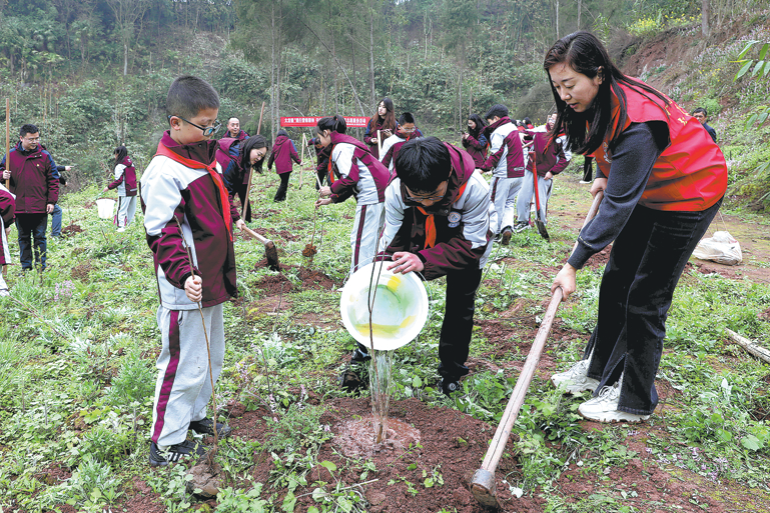BRI meets AI: Powering development through cooperation


The ancient Silk Road routes, once teemed with camel caravans, now pulses with the invisible flow of data. At the heart of this transformation lies artificial intelligence (AI), a powerful new engine of the Belt and Road Initiative (BRI).
The widening AI divide
Since the global AI boom sparked by the launch of ChatGPT at the end of 2022 started, the global AI divide has been widening, as human capital and computing resources for AI development become increasingly concentrated in a handful of countries. This trend is exacerbated by technological blockades, data exploitation, and algorithmic dominance exerted by certain Western countries aiming at cementing their technological hegemony.
In contrast, China is promoting AI international cooperation under the BRI. At the third Belt and Road Forum for International Cooperation in October 2023, China put forward the Global AI Governance Initiative, stressing that all countries, regardless of their size, strength, or social system, should have equal rights to develop and use AI. It also calls for international cooperation and assistance tailored to developing nations to bridge the AI divide.
Building on this foundation, China recently proposed a new AI+ International Cooperation Initiative at a high-level meeting on the Global Development Initiative, a side event held during the General Debate of the 80th Session of the United Nations General Assembly. The Initiative calls for deep integration of AI into the economic and social development of all countries through AI+ campaigns. As a matter of fact, international cooperation on AI development under the BRI framework has long been underway.
Advancing digital infrastructure
China has been assisting BRI partner countries in building digital infrastructure through the Digital Silk Road initiative since 2015, laying the groundwork for AI development. China's three major telecommunications operators have jointly established dozens of submarine cables, over 100 cross-border terrestrial cable systems, and a web of international network nodes spanning the Asia-Pacific, Europe, and Africa. In Indonesia, the Fiber-to-the-Home project implemented by the Chinese company Yangtze Optical Fibre and Cable Company Ltd. has been deployed in 25 cities, providing local residents with reliable Internet services. In June 2025, the first phase of the Johor Data Center project in Malaysia, constructed with the participation of China Construction Fifth Engineering Division Corp Ltd., was successfully completed.
These projects, serving as the physical backbone of the AI era, not only provide the high-speed conduits necessary for transferring the massive datasets that fuel AI models, but also pave the way for practical AI applications — from enabling remote medical diagnostics and online education platforms to providing cloud computing power.
Enhancing AI literacy
China's approach to AI collaboration focuses on building long-term capacity. The strategy aims to enable partner countries to master core AI technologies while cultivating a new generation of professionals with digital literacy and innovation capability. In September 2024 and May 2025, China held two workshops on AI capacity building for sharing expertise and technological achievements, attracting participants from nearly 80 countries and international organizations.
The workshops provided participants with comprehensive AI knowledge through a balanced mix of classroom instructions, interactive discussions, and field visits. These sessions explored topics from national AI development strategies to global governance frameworks, helping government officials strengthen their strategic planning and regulatory capabilities. Zambia's Permanent Representative to the United Nations Chola Milambo noted after attending the workshop, "China has played a leading role in helping the Global South enhance its AI capacity building. The workshop is extremely significant for implementing both the Global Digital Compact and relevant UN General Assembly resolutions." Many participants particularly valued exposure to cases where AI solutions from Chinese companies are being successfully deployed across BRI partner countries.
Charting a collaborative future: AI for good and for all
The rapid ascent of Chinese AI, exemplified by the 2025 breakthrough of the open-source model DeepSeek-R1 — which outperformed OpenAI's GPT-o1 at a fraction of the cost — has been termed a "Chinese Sputnik moment." This achievement demonstrates China's capacity for indigenous innovation, and serves as compelling proof that technological advancement cannot be held back by "small yard, high fences," offering a powerful source of encouragement to developing nations. The conscious choice to release DeepSeek as open-source from the outset underscores the belief that technological advancement springs from inclusiveness and mutual learning.
Later entrants now face two choices for AI's future: one defined by exclusivity and zero-sum competition, and another promoting openness and collaboration. China and BRI partner countries have already made their choices, because they firmly believe that true technological progress must empower all countries and serve humanity as a whole.
The author is a commentator on international affairs.
The views don't necessarily reflect those of China Daily.
If you have a specific expertise, or would like to share your thought about our stories, then send us your writings at opinion@chinadaily.com.cn, and comment@chinadaily.com.cn.



































